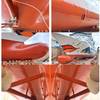Boeing Installs Sea-Based Radar's Mooring System
Manson Construction, a Boeing subcontractor, used tugs, barges and cranes to place the mooring system's eight anchors on the bottom of Kuluk Bay. Heavy machinery aboard a barge then dragged the 75-metric-ton anchors, embedding them into the sea bed. The construction team completed the installation three weeks ahead of schedule.
When SBX visits its homeport of Adak, Alaska, a small island in the Aleutian Islands, it will be chained to the anchors to keep it stationary in Kuluk Bay. SBX is a new sensor developed by Boeing for the U.S. Missile Defense Agency's GMD system, the nation's only defense against long-range ballistic missiles. Boeing is GMD's prime contractor. SBX, which consists of a radar atop a modified semi-submersible oil drilling platform, arrived in Alaskan waters in February for the first time after completing a self-propelled, 2,200-nautical-mile journey from Hawaii. During its voyage, the platform displayed its durability by successfully navigating severe winter storms in the northern Pacific Ocean, including waves more than 50 feet high and wind gusts of more than 100 miles an hour. The radar system is able to move throughout the Pacific Ocean, or any of the world's oceans, to support advanced missile defense testing and defensive operations.
During a GMD test in March, the mobile SBX, positioned in the north-central Pacific Ocean, demonstrated its capability by detecting, tracking and assessing a long-range ballistic missile target launched from Vandenberg Air Force Base, Calif. As part of the GMD system, SBX provided that target information via satellite to GMD's Colorado-based fire control system, which used the data to simulate a target shootdown with a simulated ground-based interceptor.













